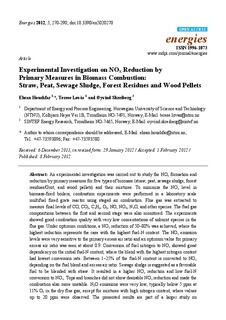| dc.description.abstract | An experimental investigation was carried out to study the NOx formation and reduction by primary measures for five types of biomass (straw, peat, sewage sludge, forest residues/Grot, and wood pellets) and their mixtures. To minimize the NOx level in biomass-fired boilers, combustion experiments were performed in a laboratory scale multifuel fixed grate reactor using staged air combustion. Flue gas was extracted to measure final levels of CO, CO2, CxHy, O2, NO, NO2, N2O, and other species. The fuel gas compositions between the first and second stage were also monitored. The experiments showed good combustion quality with very low concentrations of unburnt species in the flue gas. Under optimum conditions, a NOx reduction of 50–80% was achieved, where the highest reduction represents the case with the highest fuel-N content. The NOx emission levels were very sensitive to the primary excess air ratio and an optimum value for primary excess air ratio was seen at about 0.9. Conversion of fuel nitrogen to NOx showed great dependency on the initial fuel-N content, where the blend with the highest nitrogen content had lowest conversion rate. Between 1–25% of the fuel-N content is converted to NOx depending on the fuel blend and excess air ratio. Sewage sludge is suggested as a favorable fuel to be blended with straw. It resulted in a higher NOx reduction and low fuel-N conversion to NOx. Tops and branches did not show desirable NOx reduction and made the combustion also more unstable. N2O emissions were very low, typically below 5 ppm at 11% O2 in the dry flue gas, except for mixtures with high nitrogen content, where values up to 20 ppm were observed. The presented results are part of a larger study on problematic fuels, also considering ash content and corrosive compounds which have been discussed elsewhere. | nb_NO |
